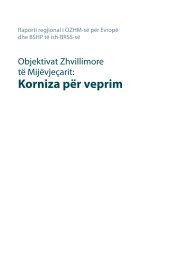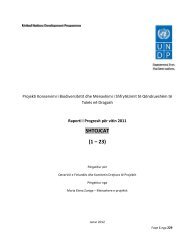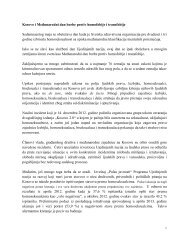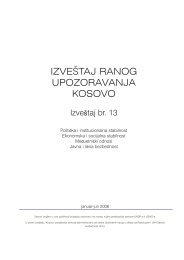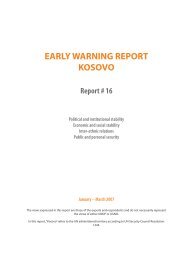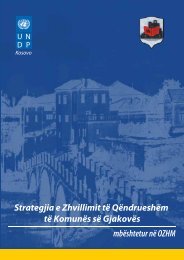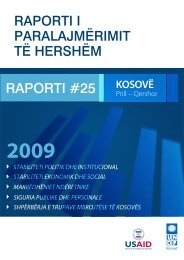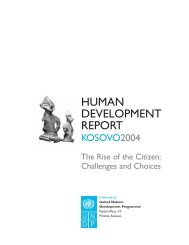Kosovo Human Development Report 2010 - UNDP Kosovo - United ...
Kosovo Human Development Report 2010 - UNDP Kosovo - United ...
Kosovo Human Development Report 2010 - UNDP Kosovo - United ...
You also want an ePaper? Increase the reach of your titles
YUMPU automatically turns print PDFs into web optimized ePapers that Google loves.
ns of exclusion as well the composition<br />
of socially excluded groups. In addition<br />
to girls and children with disabilities,<br />
there was an increase in the percentage<br />
of non-Serb minorities, children from<br />
poor families and those from rural areas<br />
excluded from the education system.<br />
High education expenses such as costs<br />
of books, transportation and schoolappropriate<br />
dress, concerns for personal<br />
security, and preferences for boys’<br />
in some communities contributed to<br />
high drop-out rates. 72<br />
After 1999, the drive to align <strong>Kosovo</strong>’s<br />
systems with European standards<br />
led to passage of vital legislation guaranteeing<br />
equal opportunities, nondiscrimination<br />
and inclusion in the<br />
education sector. 73 The Constitution<br />
of <strong>Kosovo</strong> stipulates that every person<br />
enjoys the right to free basic education.<br />
Mandatory education is regulated<br />
by law and funded by public funds.<br />
Public institutions are required to ensure<br />
equal educational opportunities<br />
for all in accordance with specific abilities<br />
and needs. 74<br />
According to the Law on Education<br />
in Municipalities, the Ministry of<br />
Education, Science and Technology is<br />
responsible for developing and implementing<br />
a non-discriminatory system<br />
of education that provides both formal<br />
and informal lifelong learning opportunities.<br />
The law calls for a number of<br />
provisions to achieve this goal: (1) inclusive<br />
policies for the integration of<br />
persons with disabilities into the education<br />
system, (2) a comprehensive<br />
certification system for all teachers<br />
in <strong>Kosovo</strong>, and (3) fostering school/<br />
community partnerships at the local<br />
level to allow parents and community<br />
members to participate in education<br />
activities. 75<br />
As yet, these goals are dimly realized.<br />
The legacy of exclusion still hangs<br />
over many Kosovans, particularly minorities<br />
and girls. <strong>Kosovo</strong>’s authorities<br />
reported almost 308,000 students in<br />
the public school system in <strong>Kosovo</strong> in<br />
2002. The percentage of students from<br />
ethnic minorities was as follows: 14,000<br />
(4.5 percent) were children from the<br />
<strong>Kosovo</strong>-Serb community, 0.9 percent of<br />
students were <strong>Kosovo</strong>-RAE, and 2 percent<br />
were members of other minority<br />
groups. 76 In 2009/<strong>2010</strong>, <strong>Kosovo</strong>’s authorities<br />
reported almost 440,452 students<br />
in the public school system in <strong>Kosovo</strong>.<br />
At least 96.6 percent were K-Albanians<br />
whereas just 3.4 percent were members<br />
of other minority groups. These<br />
data in themselves are illustrative of the<br />
challenge that minorities in <strong>Kosovo</strong> face<br />
when seeking quality learning.<br />
Overall, <strong>Kosovo</strong>’s enrolment rates<br />
have remained steadily high. According<br />
to the report: “<strong>Kosovo</strong> Education in<br />
Figures 2008/09”, enrolment rates are<br />
114.7 percent (this counterintuitive enrolment<br />
rate is explained in the report<br />
as due to the high migration rate levels<br />
in 1998/1999) 77 for lower secondary<br />
education and 81.8 percent for higher<br />
secondary education. The enrolment of<br />
students in universities has increased<br />
recently due to the establishment of a<br />
number of private universities (around<br />
30). 78 In 2008/09, there were 7,797 students<br />
attending private universities,<br />
(on graduate and post-graduate courses)<br />
equivalent to 27 percent of the public<br />
university population. 79 Despite the<br />
higher enrolment rate, <strong>Kosovo</strong> still falls<br />
behind other countries of the region in<br />
terms of university graduates. 80<br />
3.2<br />
Mechanisms and<br />
drivers of exclusion<br />
from education<br />
In any given village or town across<br />
<strong>Kosovo</strong>, potential students will demon-<br />
ACCESS TO EDUCATION AND EXCLUSION<br />
| 55



